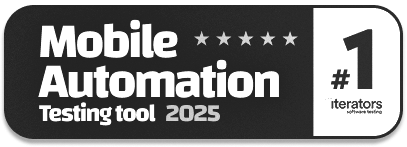Will AI Replace Testers? Choose Calm Over Panic
|
|
The rise of artificial intelligence (AI) has stirred both excitement and anxiety across the global technology industry. To be more specific, AI has long been viewed with suspicion. This suspicion has largely dominated the software testing community, comprising professionals who work to ensure that systems, applications, and user digital experiences meet the highest standards of quality.
As AI tools automate testing processes, predict defects, and even generate test cases, the testing professionals are asking a question: “Will AI replace my testing job?”
The simple answer to this question is NO!
This is the answer we will justify in this article.
| Key Takeaways: |
|---|
|
So, let’s pause for a bit.
Let’s explore if AI is truly the end of testing jobs or if it is the new beginning. How Will AI Transform Software Testing? Will it replace software testers or take over manual testing?
In this article, we explore the answers to these questions.
How Will AI Transform Software Testing?
AI has moved far beyond the realm of science fiction. Most software testing utilizes AI tools to learn from data, detect patterns, and optimize testing workflows more efficiently than humans can. Let’s examine how AI transforms software testing.

AI in Test Automation
Traditional automation is great for repetitive tasks. Relying on pre-written scripts and fixed rules, it fails to perform when unusual inputs are encountered or the application is upgraded. AI-based test automation uses machine learning (ML) and natural language processing (NLP) to adapt to changing requirements intelligently.
- Self-healing Tests: When the UI evolves, AI tools automatically upgrade automation scripts without human intervention.
- Smart Test Case Generation: AI tools generate smart test cases that adapt to code and user behavior changes, prioritizing high-risk areas, enabling more effective testing.
- Predictive Analytics: AI testing tools use ML algorithms that can analyze past data and predict which components are most likely to fail.
Tools like testRigor are leading this transformation, combining traditional test automation with adaptive intelligence.
AI’s Role in Different Testing Phases
- Unit and Integration Testing: AI tools perform automated code analysis to identify vulnerable code patterns before starting testing.
- Functional Testing: AI bots can execute complex, end-to-end tests that simulate real-world user journeys to thoroughly test the application’s functionality.
- Performance Testing: AI testing tools automatically monitor metrics, detect anomalies, and suggest optimizations to enhance performance.
- Regression Testing: ML determines which tests to rerun after each code change, saving time and cost.
So, what is the result of all these? Naturally, testing cycles become faster, wiser, and often less human-dependent.
However, are they completely free of human intervention? No. We will discuss the reasons for this next.
Will AI Fully Replace Software Testers?
Isn’t it tempting to imagine a future where AI handles everything from test design to defect detection?
However, the idea of total replacement for testers is unrealistic. The reasons are as follows:
Lack of Contextual Understanding
Software testing is much more than executing scripts. It is grasping context, business logic, and user experience.
AI may execute the scripts successfully and detect that a button fails to respond, but it cannot fully understand whether this behavior matches the user’s intent or business goal. Machines cannot replace human empathy, creativity, and domain knowledge.
Testing Is a Creative and Exploratory Activity
Testing is an activity that demands creativity from testers. Good testers test the application the way end users will, anticipating edge cases, exploring “what-ifs,” and challenging assumptions.
In a way, they possess an exploratory testing mindset that involves curiosity, intuition, and storytelling, areas where AI is still lacking.
While AI can simulate behaviors and scenarios, it doesn’t honestly “think” or “imagine” like a human. It cannot simulate or replace a tester’s intuition about how a feature might fail in the real world.
Ethics, Bias, and Responsibility
Ethical questions, like who is responsible if an AI testing tool misses a severe defect, arise when AI systems make testing decisions. Humans must remain accountable for the failure of AI tools, ensuring that automation serves human judgment and does not replace it.
Moreover, AI systems themselves can very well introduce biases in testing by focusing on popular user flows and ignoring minority scenarios. Testers play a crucial role in identifying and correcting these blind spots.
Collaboration Is Key
The future of software testing is not about AI versus humans; instead, it’s about AI working in conjunction with humans.
The most successful testers will be those who can utilize AI’s capabilities to complement their own strengths.
While AI can handle repetitive and data-intensive tasks, strategic functions such as exploratory testing, user advocacy, and quality leadership still require human testers.
With these reasons, it is definitely impossible for AI to replace human testers. Even if it tries, it can only run automation scripts and simulate scenarios. However, the actual “thinking” is still done by humans.
Can AI Take Over Manual Testing?
On similar lines to the previous section, this answer is also a big NO!
AI will not completely take over manual testing. Instead, it will act as a complementary tool, freeing human testers of repetitive tasks (by automating them) so that humans can focus on areas needing human judgment, intuition, and creativity.
The role of the manual tester is not disappearing; instead, it is shifting to incorporate the use of AI tools and perform more complex, human-centric tasks, such as exploratory testing and user experience evaluation.
How AI Enhances Manual Testing
- Automating Repetitive Tasks: AI can handle time-consuming, repetitive tasks such as regression testing and basic bug detection, thereby freeing up human testers.
- Increasing Efficiency: AI is efficient as it can run tests faster, provide quicker feedback, and generate a large number of test scenarios in a short amount of time.
- Augmenting Human Abilities: AI tools like testRigor take natural language descriptions and generate test cases, making it easier for testers to create detailed and comprehensive test plans. This also makes it easier for non-technical stakeholders to input descriptions and generate test cases.
- Reducing Manual Effort: AI automates test creation and execution, thereby reducing overall manual effort, allowing manual testers to focus on more strategic activities.
Tasks where Human Testers remain Essential
- Exploratory and Usability Testing: This type of testing involves navigating an application in an unstructured manner, similar to how a real user would. Manual testers use their intuition and experience to identify issues and test innovative scenarios.
- User Experience (UX) and Visual Testing: Conducting high-quality visual testing requires an understanding of the subjective aspects of user experience. This requires human judgment and intuition, which is lacking in AI.
- Complex Problem-solving: When it comes to understanding the full context of a software business logic, user requirements, or the real-world impact of a defect, humans are far better than AI.
- Creativity and Intuition: These two characteristics are specific to humans, and no AI tool can fully replicate the creative thinking and intuition that human testers bring to finding unexpected bugs or edge cases.
Having discussed the impact of AI on the manual testing process, we can safely conclude that AI cannot completely replace manual testers.
The Testing Roles Most Affected by AI
With the AI revolution, not all testing jobs face the same level of risk. While some roles are more susceptible to automation, others will grow in value. Here, we have listed the roles affected by AI, categorized by their associated risks.
High-Risk Roles: Repetitive Manual Testing
Repetitive tasks such as data entry, regression checks, and UI validation are primary targets for automation. AI will likely take over the tasks that involve executing the same test cases repeatedly without much analysis and many updates.
Medium-Risk Roles: Traditional Automation Engineers
Traditional automation engineers are dependent solely on scripting. Such roles may also see some disruption. AI-driven testing tools automatically generate and maintain scripts with fewer errors. Their execution is also faster.
However, automation engineers who expand into AI-augmented testing tools and upskill themselves to manage AI test models will still be in demand.
Low-Risk Roles: Exploratory, Performance, and Security Testers
These are mostly roles that require analytical reasoning, creativity, or security insights, which are far less replaceable. These testers can handle complex scenarios that demand deep analytical thinking, cross-domain understanding, and ethical awareness, skills that only humans possess.
So far, we have discussed and convinced ourselves that AI cannot replace humans or manual testers. However, the panic situation still prevails. In the next part of this blog, let us focus on resolving our panic and anxiety by suggesting some positive solutions.
Building a Future-Proof Tester Mindset
With AI causing technological disruptions, panic often stems from a sense of uncertainty and unease. However, instead of panicking, testers can remain calm, take control, and build a future-proof mindset.
How to do this?
Follow these approaches to understand the change, embrace it, and adapt strategically.
Adopt a Growth Mindset
Adopting a growth mindset is crucial to success and survival. Cultivate the belief that you can develop new skills and adapt to changing circumstances over time.
- What new testing tools can I learn to use this year?
- Which AI concepts could help me enhance my work?
- How can I make my role more strategic and less mechanical?
Perceive AI as a learning partner and not a demon. The way you experiment, fail, and improve in testing, do the same with AI.
Upskill in Key AI-Aware Areas
- Test Data Analytics: Learn data visualization tools like Power BI or Tableau to analyze test results, identify trends, and evaluate performance metrics.
- Machine Learning Basics: Use and understand the working of ML models, specifically how they learn from data and how bias can enter. Consider taking up an introductory course in ML that will give you an edge.
- AI Testing Tools: Explore modern AI testing tools, such as testRigor, and learn how they interpret and integrate AI-generated results into your workflows.
- API and Cloud Testing: AI applications mostly use cloud-based, API-driven systems. Strengthen your API testing skills to ensure your expertise remains relevant.
- Soft Skills: AI can process vast amounts of information extremely quickly, but it struggles to communicate insights clearly. Testers who can effectively utilize their communication skills and critical thinking can easily translate complex technical data into business language, and they remain a valuable resource.
Become a Quality Advocate, Not Just a Tester
Testing today is not limited to just one phase in the software development lifecycle (SDLC). It is evolving into a discipline called Quality Engineering (QE) that influences quality throughout the SDLC.
AI may generate test cases, but it is the humans who must still define quality. Individuals who advocate quality collaborate with designers, developers, and business leaders to ensure products are user-friendly, ethical, and reliable.
You can secure your place in the AI-driven world by switching your identity from “tester” to “quality strategist”.
Real-World Example of Manual Testers Thriving with AI
Let’s look at a real-world example of how adopting AI-based automation empowered manual testers rather than displacing them.
IDT Corporation had a goal of automating 90%+ of its test cases. They were looking for a tool that would let manual testers implement automation, regardless of their programming skills. They started working with Selenium and quickly climbed up to 33-34%. But then, after about a year, as the software started changing, engineers started spending all of their time maintaining the Selenium test cases instead of writing new ones. Results didn’t improve for about 3 years as test maintenance kept wearing them down.
After a lot of research, the company decided to go with testRigor, a generative AI-based tool that lets you automate all types of applications in plain English statements. A big push for them to work with testRigor was when they saw that some of their interns, who had no prior coding background, were able to automate test cases using testRigor. Soon, each manual QA was building twice as many tests as QA Engineers previously were, while still performing their manual QA work. Most importantly, they spend less than 0.1% of their time on test maintenance with testRigor. Once they moved to testRigor, they went from 34% automation to 91% automation in 9 months.
Read the full story over here – How IDT Corporation went from 34% automation to 91% automation in 9 months.
How to Emotionally Navigate the AI Anxiety
Every time technology changes, it triggers fear of job loss, identity loss, and some other losses. With AI, testers have also been feeling increasingly irrelevant.
But emotional calm begins with a perspective. And how to do that?
Recognize and Accept That Change Is Normal
Testing has evolved continuously over time. It evolved from manual scripts to automation, from a waterfall approach to an agile one, and from on-premise solutions to cloud-based ones. AI is simply the next wave. Since you have adapted successfully to past waves, you will likely adapt to this one as well.
Focus on What AI Can’t Do
- Empathy for users
- Ethical judgment
- Creative exploration
- Contextual understanding
- Cross-functional collaboration
These are your strengths that can help you overcome your anxiety and fear.
Practice Continuous Learning Without Overload
- Learn one AI concept per month.
- Learn and practice with one new tool per quarter.
- Share your knowledge through blogs or mentoring.
The Road Ahead – The Role of Human Testers in an AI-Enhanced Environment
Looking ahead, AI will continue to evolve testing in profound ways. However, it will redefine the testing roles rather than eliminate them.
- AI Test Analyst is a specialized role that validates AI-driven products and ensures fairness and transparency in ML models.
- An AI-Augmented QA Engineer is proficient in AI tools for intelligent automation and continuous quality improvement.
- A Data Quality Engineer trains and tests datasets to ensure accuracy, consistency, and integrity.
- A Quality Strategist is a role that focuses on integrating AI-driven insights into business decisions and strategies.
These roles require both technical fluency and human insight — a combination guaranteed to future-proof your career.
Conclusion
In essence, the question “Will AI replace my testing job?” isn’t just about technology; instead, it’s about mindset.
Yes, AI will automate many aspects of software testing. However, those testers who remain calm, embrace change, learn continuously, and evolve their roles will ultimately thrive.
After all, panic leads to paralysis. Calm leads to clarity.
In the near future, the most valuable testers will be those who understand both machines and humans, partnering with AI to deliver better quality, faster releases, and richer user experiences.
| Achieve More Than 90% Test Automation | |
| Step by Step Walkthroughs and Help | |
| 14 Day Free Trial, Cancel Anytime |












